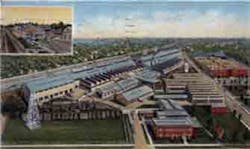General Electric’s GE Oil & Gas business is starting an extensive, $60-million modernization and rebuilding of the Lufkin, TX, gray and ductile iron foundry it acquired last year. According to GE and sources familiar with the project, the decision is rooted in the oil-and-gas sector’s increasing demand for castings used in exploration, extraction, and refining.
GE bought Lufkin Industries for $3.3 billion in April 2013, incorporating its line of oilfield rigs, pumps, and related equipment into the GE Oil & Gas business. Lufkin products are used worldwide to extract oil-and-gas products, and are in particular demand for recovering shale oil reserves and “liquids rich” fields.
Now, the plan is for GE to demolish 30,000 sq.ft. of Lufkin’s 515,000-sq.ft. foundry, and build 72,000 sq.ft. of new space at that site, where metalcastings have been in production since 1902. GE also will refurbish the remaining facilities there. It explained that the redesigned operation will have a simpler production process flow, better working conditions for employees, and improve product quality and delivery schedules.
Details of the new design, including the manufacturing equipment, have not been reported.
“We chose to invest in modernizing and improving our existing foundry because of the rich history and dedicated, skilled workforce associated with the Lufkin operation here in Texas,” according to Jerome Luciat-Labry, president of Well Performance Services for GE Oil & Gas. “The goal is to make the facility as efficient as possible and help strengthen the competitive position of our business around the world.”
The Lufkin business produces various oilfield-pump designs, well automation systems, gas lift and plunger lift systems, progressing cavity pumps, and well completion products. It also produces power transmission products.
Most of the castings for those products are produced at the Texas foundry, which currently has an estimated output of 72,000 tons per year. According to GE, 87% percent of the foundry’s output supports the Lufkin product line, and the remainder is for external customers.
GE did not indicate the anticipated capacity of the rebuilt operation.
“By having its own foundry, GE Oil & Gas has a strategically integrated supply chain that allows the company to more rapidly meet the needs of its customers, particularly in the fast-growing unconventional oil and gas sector,” according Luciat-Labry.
The project will be carried out in four stages, starting in 2016 and continuing for about three years, GE indicated.










